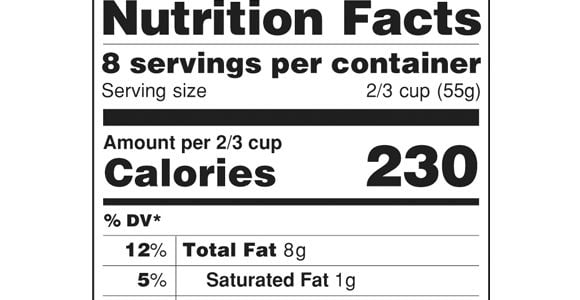Earlier this year, the Food and Drug Administration proposed a much-needed update on the nutrition-facts labels you see on the back of packaged foods--and it's a change for the better. With the current system being notoriously hard to decipher when you're watching fat, sugar and calorie intake, the new version will be much more clear. This is good news, although some people may be in for a surprise when they learn how fattening some of their favorite foods really are.
First Lady Michelle Obama weighed in on the subject in a press release,
saying, "You as a parent and a consumer should be able to walk into your
local grocery store, pick up an item off the shelf, and be able to tell
whether it's good for your family. So this is a big deal, and it's
going to make a big difference for families all across this country."
Here are five changes you should expect to see.
1. Serving Sizes
One of the biggest changes will be how serving sizes are calculated. The old guidelines were established 20 years ago, when portions were decidedly smaller than they are today. So while a 20-ounce bottle of soda may now be labeled as having multiple servings, the new label will treat the entire bottle as just one serving. This is more aligned with the way people really eat, according to the FDA.
On larger packages, you'll now see two columns: one with the nutrition info per serving, and another with facts for the entire package. So if you gorge on potato chips one night, you'll know exactly how much you've eaten once the bag is empty.
2. Calories
You can expect to see calories printed in a larger font than before. The FDA really wants you to know how much you're eating--which makes sense, considering one third of Americans are currently obese.
3. Sugar
Another new and welcome feature is a value for added-sugar content. The American Heart Association recommends that men get 150 or fewer calories from added sugar per day, and that women get 100 or fewer calories from added sugar per day. On the old label, there was no way of knowing if sugar was added, or if it was originally contained in the food. For example, canned peaches will naturally contain sugar, even if they're simply packed in juice. A can of peaches in heavy syrup, however, may be loaded with added sugars.
4. Sodium
You'll also see changes in sodium content, as the daily value is now 2,300 mg per day instead of 2,400 mg per day. Expect to see some new nutrients on the label as well, such as vitamin D, potassium, calcium and iron. While these used to be voluntarily listed on certain foods, they will now be required.
5. Items Removed
Some items are slated to disappear from the new label. For example, you'll no longer see a "calories from fat" value because the FDA says it's the type of fat you eat, not the amount, that really matters for your health.
If you have something to say about the new food labels, the government is listening; they've established a 90-day comment period to hear your input. To add your two cents, visit regulations.gov and tell them what you think.
Nina Kate is a certified fitness nutrition specialist through the National Academy of Sports Medicine (NASM). She also studied journalism at the University of California, Los Angeles (UCLA), and has contributed to numerous major publications as a freelance writer. Nina thrives on sharing nutrition and fitness knowledge to help readers lead healthy, active lives. Visit her wellness blog at BodyFlourish.com.



